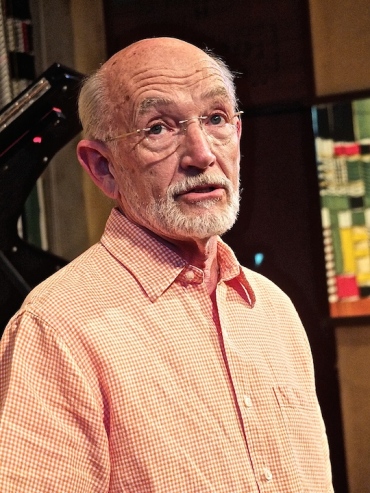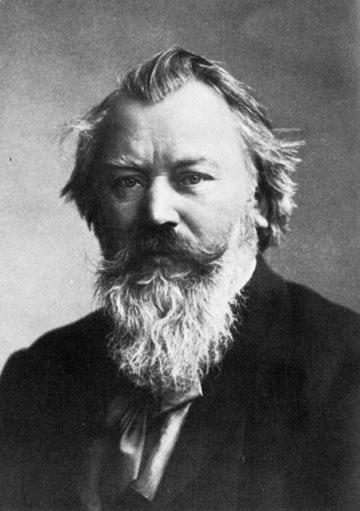The Well-Tempered Ear
Classical music: A “German” Requiem by Johannes Brahms will be performed for FREE on Sunday and Monday in the Hillside Theater at Frank Lloyd Wright’s Taliesin compound in Spring Green.
Leave a Comment
By Jacob Stockinger
Is there any better choral music to mourn the dead than the “German” Requiem by Johannes Brahms? The Ear doesn’t think so.
So I was pleased when longtime friend of and contributor to this blog Kent Mayfield (below), who directs the Rural Musicians Forum, wrote to The Ear about an upcoming MUST-HEAR concert in Spring Green:
“The beloved German Requiem by Johannes Brahms receives long-anticipated local attention in Spring Green on this coming Sunday, August 10, and next Monday, August 11.
The Sunday performance is at 5 p.m.; the Monday performance is at 7:30 p.m. Both performances will be in the architecturally unique Hillside Theater (below) on the Taliesin estate of architect Frank Lloyd Wright.
Conducted by Taliesin’s music director, Effi Casey, the work is a powerful, profoundly moving work with a spiritual message that is as enduring as it is distinctly modern.
Its immediate inspiration may well have been the death of Brahms’ mother and, probably, the death of Robert Schumann, as well.
But the focus in Brahms’ German Requiem — his first large-scale work — is not so much on the departed as on those left behind and the work of memory. (You can hear that emphasis in the gloriously beautiful and moving concluding movement, “Blessed Are the Dead for Their Works Live After Them” in a YouTube video at the bottom.)
Instead of the traditional Latin liturgical text, Brahms (below) uses passages from the Bible (Old Testament and New Testament plus the Apocrypha) that emphasize a sense of the mystery and fragility of life and inevitability of death, the hope for the future, and the value of patience and endurance.
In this way, A German Requiem creates a sense of spirituality in a secular age. This is a “human” or “humanistic” rather than merely a “German” requiem.
The music can be lush, and vivid orchestral detail and radiant voices ensure plenty of momentum and buoyancy.
For the Spring Green performances, a notable orchestra of professional caliber has been assembled uniquely for these concerts.
The Taliesin Chorus, drawn from across southwestern Wisconsin, will be joined by soloists Monica Dunn, Madeline Ehlinger and Carl Leaf, to make sense of the text, sung in German, with insight and sensitivity. (Below is a rehearsal photo taken by Dick Ainsworth, who also shoots great photos for the Bach Dancing and Dynamite Society.)
Taliesin’s Hillside Theater is located at 6604 State Hwy 23, Spring Green. The concert begins at 5 p.m. on Sunday; 7:30 p.m. on Monday. Seating is limited.
The concert is sponsored by the Rural Musicians Forum and is underwritten in part by a grant from the Spring Green Area Arts Coalition and generous gifts from the choir itself and others in the community.
There is no admission charge for the concert. However, a free-will offering assists in providing further support for the event.
For more information: www.ruralmusiciansforum.org OR contact Kent Mayfield ruralmusiciansforum@yahoo.com
The “German” Requiem happens to be The Ear’s favorite large-scale choral work, rivaled only perhaps by the calm and reassuring Requiem by French composer Gabriel Faure. So he asked Taliesin’s music director and conductor Effi Casey (below), who is leading the German Requiem, what she wanted to say about the work. Here is her reply:
People said: ‘“You want to do the Brahms Requiem? Isn’t that reaching a bit high for a non-professional director and chorus?”’
“Of course it is!” I answer. “But the dream of introducing a beautiful work like the Requiem to a community who might not easily have the opportunity, let alone the possibility to experience such a work “from within,” has been a long harbored desire of mine.
“Brahms himself might have called his Requiem “A Human Requiem” but chose to differentiate it from other Requiem settings, commonly known with liturgical Latin texts as part of the Catholic Mass.
“I cannot imagine anyone, whether amateur or professional, NOT being affected by a work that expresses the complexities of the human existence, blessings, hope, fear, death, sorrow, transformation, comfort and peace in such a deeply moving form as Brahms’ Requiem.
“As Clara Schumann (below left, with Robert on the right) –- whom Brahms loved and hoped to marry after the death of her husband Robert — wrote in her diary:
‘“Johannes has been playing me some magnificent movements out of a Requiem of his own and a string quartet in C minor. The Requiem delighted me even more, however. It is full of tender and again daring thoughts. I cannot feel clear as to how it will sound, but in myself it sounds glorious.”’
“Drawing on the amazing talent in our community and being supported by many professional musicians in the orchestra, the study of the Brahms German Requiem has been immensely rewarding for all of us.
“As part of a quote by Walt Whitman reads in Frank Lloyd Wright’s Taliesin Hillside Theater: “… Something there is in the float of the sight of things that provokes it out of the soul…”
“We hope to stir the souls of the listeners with our two performances of the glorious “German” Requiem by Brahms.”
Tags: Arts, Brahms, Chamber music, Choir, choral music, chorus, Clara Schumann, Classical music, Faure, Frank Lloyd Wright, German, German Requiem, humanistic, Jacob Stockinger, Johannes Brahms, Music, New Testament, Old Testament, Orchestra, Requiem, Robert Schumann, Rural Musicians Forum, Schumann, secular, Taliesin, Walt Whitman, YouTube





